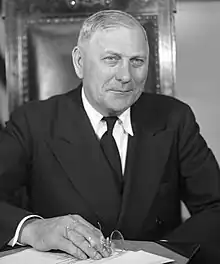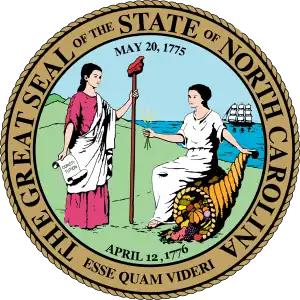R. Gregg Cherry | |
|---|---|
 R. Gregg Cherry, 1945 | |
| 61st Governor of North Carolina | |
| In office January 4, 1945 – January 6, 1949 | |
| Lieutenant | Lynton Y. Ballentine |
| Preceded by | J. Melville Broughton |
| Succeeded by | W. Kerr Scott |
| Mayor of Gastonia, North Carolina | |
| In office 1919–1923 | |
| Personal details | |
| Born | Robert Gregg Cherry October 17, 1891 York County, South Carolina, U.S. |
| Died | June 25, 1957 (aged 65) Gastonia, North Carolina, U.S. |
| Political party | Democratic |
| Spouse | Lula Mildred Stafford |
| Alma mater | Duke University |
Robert Gregg Cherry (October 17, 1891 – June 25, 1957) was an American politician and lawyer who served as the 61st governor of the U.S. state of North Carolina from 1945 to 1949.
Biography
Born in York County, South Carolina near Rock Hill, Cherry grew up in Gastonia, North Carolina with relatives after the death of his parents. He earned bachelor's and law degrees at Trinity College (now Duke University).[1] He organized and led a volunteer artillery company during World War I.
In 1921, he married Lula Mildred Stafford, the daughter of the Mayor of Greensboro Emory Junius Stafford.[2]
Cherry served as mayor of Gastonia from 1919 to 1923,[3] as a member and speaker of the North Carolina House of Representatives, as chairman of the North Carolina Democratic Party (1937–1940), and as a member of the North Carolina Senate. In Gastonia, it was joked that he was the best lawyer in town when sober, and the second-best lawyer in town when drunk.[4]
In 1944, Cherry was elected governor as the last in a series of governors affiliated with the political machine of former governor O. Max Gardner.[5] He was sworn in on January 4, 1945.[6] Cherry inherited an economy facing material and labor shortages as a result of the ongoing Second World War. One of his primary focuses during his term was the improvement of mental health care at state-run facilities. Cherry Hospital in Goldsboro, North Carolina, is named for him.
Unlike most other Southern Democratic governors, Cherry supported Harry S. Truman for re-election in 1948. He was succeeded by W. Kerr Scott on January 6, 1949.[6] He retired from politics and returned to the practice of law.
References
- ↑ "North Carolina manual [serial]".
- ↑ Ham, Marie Sharpe; Blake, Debra A.; Morris, C. Edwards (2000). North Carolina's First Ladies 1891-2001, Who Have Resided in the Executive Mansion At 200 North Blount Street. Raleigh, North Carolina: The North Carolina Executive Mansion Fine Arts Committee and the North Carolina Executive Mansion Fund, Inc. pp. 51–52. ISBN 0-86526-294-2.
- ↑ https://www.nga.org/governor/robert-gregg-cherry/#:~:text=In%20his%20first%20political%20campaign,of%20the%20house%20in%201940
- ↑ Tar Heel Laughter By Richard Walser
- ↑ Christensen, Rob. The Paradox of Tar Heel Politics. 2008. UNC Press.
- 1 2 Cheney 1981, p. 423.
Works cited
- Cheney, John L. Jr., ed. (1981). North Carolina Government, 1585-1979 : A Narrative and Statistical History (revised ed.). Raleigh: North Carolina Secretary of State. OCLC 1290270510.
